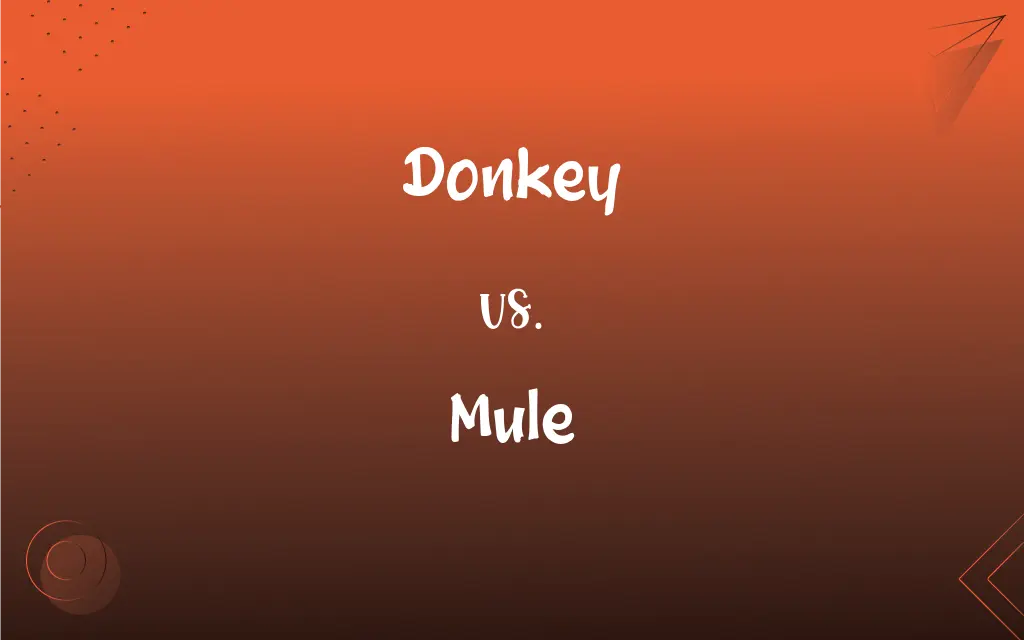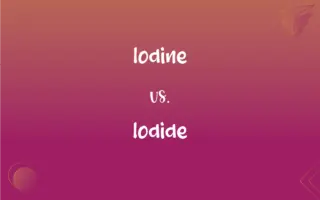Donkey vs. Mule: What's the Difference?
Edited by Janet White || By Harlon Moss || Updated on October 28, 2023
A donkey is a domesticated member of the horse family, while a mule is the offspring of a male donkey and a female horse.

Key Differences
Donkeys and mules, while closely related, have distinct differences rooted in their genetics and lineage. A donkey is an independent species, known scientifically as Equus asinus, domesticated from wild African ancestors. On the other hand, a mule is a hybrid creature, resulting from the cross between a male donkey (jack) and a female horse (mare).
The physical attributes of donkeys and mules also offer contrasts. Donkeys typically have a stout build, long ears, and a tasseled tail. Mules, due to their hybrid nature, often exhibit a combination of features from both parents. They tend to have a more robust physique than donkeys, inheriting the size and strength of a horse but the endurance and sure-footedness of a donkey.
Beyond physicality, the temperament of donkeys and mules differs as well. Donkeys are known for their patient, gentle, and, at times, stubborn nature. Mules, while also exhibiting some of the donkey's calm demeanor, often possess the intelligence and agility of horses, making them excellent work animals in various capacities.
In terms of fertility, donkeys, being a natural species, can reproduce. However, mules, due to their hybrid origins, are typically sterile and cannot produce offspring. This sterility in mules is a consequence of the mismatched number of chromosomes they inherit from their donkey and horse parents.
In summary, while both donkeys and mules belong to the horse family and share certain attributes, they are differentiated by their lineage, appearance, temperament, and reproductive capabilities. Donkeys stand as a unique species, while mules represent a blend of both donkey and horse traits.
ADVERTISEMENT
Comparison Chart
Origin
Independent species (Equus asinus)
Hybrid (male donkey & female horse)
Physical Features
Stout build, long ears, tasseled tail
Blend of horse & donkey features
Temperament
Patient, gentle, sometimes stubborn
Calm like donkeys, agile & smart like horses
Reproductive Ability
Can reproduce
Typically sterile
Use
Pack animal, farming, riding
Work animal due to strength, agility, & endurance
ADVERTISEMENT
Donkey and Mule Definitions
Donkey
Donkeys have long ears and a tasseled tail.
The children enjoyed petting the donkey's soft, long ears at the farm.
Mule
Mules have a varied appearance, often blending features of both parent species.
The mule had the strong body of a horse but the long ears characteristic of a donkey.
Donkey
A donkey is a domesticated hoofed mammal of the horse family.
The farmer used the donkey to carry heavy loads across the field.
Mule
Mules are typically sterile and cannot reproduce.
Despite their inability to have offspring, mules are highly valued work animals.
Donkey
Donkeys are used worldwide for transport and agricultural purposes.
In some cultures, the donkey plays a vital role in daily transportation.
Mule
A mule is a hybrid animal, a cross between a male donkey and a female horse.
Mules are favored in mountainous terrains because of their sure-footedness.
Donkey
The male donkey is referred to as a "jack" and the female as a "jenny."
The farmer decided to breed his jack donkey with a jenny from a neighboring farm.
Mule
Mules combine the strength of horses with the endurance of donkeys.
The mule carried the heavy load uphill without showing any signs of fatigue.
Donkey
A donkey is known for its patient and sometimes stubborn demeanor.
The donkey stood still, refusing to move, much to the farmer's chagrin.
Mule
Mules have been used for transportation, farming, and even military purposes.
During the war, mules were essential for transporting supplies over rough terrains.
Donkey
The domesticated ass (Equus asinus), having long ears and a loud bray.
Mule
The sterile hybrid offspring of a male donkey and a female horse, characterized by long ears and a short mane.
FAQs
Are mules fertile?
Typically, mules are sterile and cannot reproduce.
Why are donkeys sometimes seen as stubborn?
Donkeys have a cautious nature, often perceived as stubbornness, to ensure safety.
What is a donkey?
A donkey is a domesticated member of the horse family, known as Equus asinus.
How is a mule created?
A mule is the offspring of a male donkey (jack) and a female horse (mare).
How long do donkeys typically live?
With proper care, donkeys can live for 25 to 30 years or more.
Which is larger, a mule or a donkey?
Mules are generally larger, inheriting the size of horses but can vary based on parent sizes.
What is the primary use of donkeys?
Donkeys are often used as pack animals, for farming tasks, and for riding.
Are mules used in races like horses?
While not as common as horse racing, mule races do occur in certain parts of the world.
Do donkeys need special care?
Like all animals, donkeys require proper shelter, diet, and medical attention.
Is it true that mules have a calm temperament?
Yes, mules generally have a calm demeanor, inherited from the donkey side of their lineage.
Are there wild donkeys?
Yes, there are wild donkeys, also known as wild asses, in various parts of the world.
Is it true that mules can't reproduce?
Generally, mules are sterile due to the mismatched number of chromosomes from their parents.
What do donkeys typically eat?
Donkeys mainly eat grass, hay, and may receive grains or treats in moderation.
Can you ride a mule?
Yes, mules are often ridden, especially in rugged terrains where they excel.
How strong is a mule compared to a donkey?
Mules are generally stronger due to their larger size and horse lineage.
Are there different breeds of donkeys?
Yes, there are various breeds of donkeys, each with unique characteristics.
Why are mules considered good work animals?
Mules combine the strength of horses with the endurance and sure-footedness of donkeys.
How can you differentiate a donkey from a mule?
Donkeys typically have a more uniform look, while mules exhibit blended features of both horses and donkeys.
Can mules be trained easily?
Mules are intelligent and can be trained, but they also require consistent and patient handling.
Do mules have a specific sound like donkeys?
Mules have a unique bray, but it can vary, sometimes sounding more like a horse's neigh.
About Author
Written by
Harlon MossHarlon is a seasoned quality moderator and accomplished content writer for Difference Wiki. An alumnus of the prestigious University of California, he earned his degree in Computer Science. Leveraging his academic background, Harlon brings a meticulous and informed perspective to his work, ensuring content accuracy and excellence.
Edited by
Janet WhiteJanet White has been an esteemed writer and blogger for Difference Wiki. Holding a Master's degree in Science and Medical Journalism from the prestigious Boston University, she has consistently demonstrated her expertise and passion for her field. When she's not immersed in her work, Janet relishes her time exercising, delving into a good book, and cherishing moments with friends and family.































































